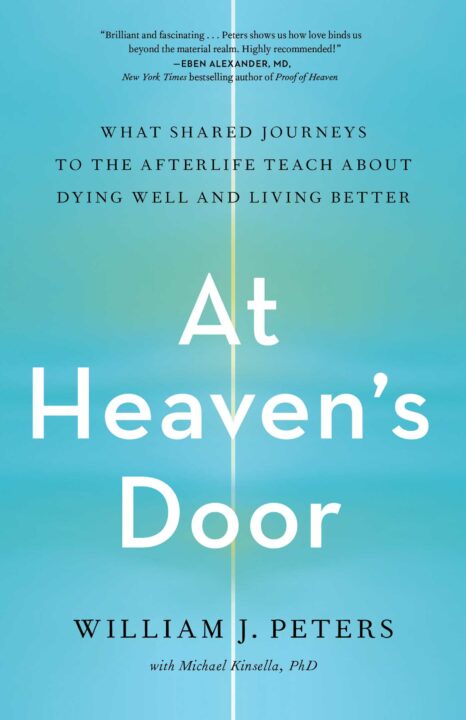
AT HEAVEN’S DOOR
What Shared Journeys to the Afterlife Teach about Dying Well and Living Better
By: William J. Peters
Published: January 4, 2022
Publisher: Simon & Schuster
Non-Fiction

Many of us have heard about moments where someone “just knew” that a person they loved had died. They had a “feeling” or they felt something shift in their bodies. In my work in Hospice in the late 1990s, I also heard of numerous “death experiences” from patients and their families. The author William Peters was also working in Hospice in 2000 when he experienced a shared death experience with a dying patient. That experience was so different than anything he had heard about that he spent 20 years researching and gathering stories from others who have experienced something similar.
Peters, through the Shared Crossing Research Initiative, has studied a range of end-of-life experiences. You can find more information at SharedCrossing.com/research. A shared death experience is defined as:
an experience that occurs when an individual feels that they have somehow shared in a dying person’s transition from this life to whatever lies beyond.
Many that have experienced a shared death have been said to witness the crossing from this life to the next, to have guided the person towards something new and beautiful, and even have accompanied them part of the way on their final journey. The majority, 64%, were physically distant from the person who was dying when they experienced a Shared Death Experience (SDE) in the cases studied. An unusual phenomenon occurred most often, with 88% sharing a vision of the dying person (often a younger version), a brilliant light, alterations of time and space, or the presence of previously deceased loved ones.
The stories shared by those who experienced an SDE were emotional, but also mostly healing. Each of the experiences Peters shares in the book offers the hope of a life after death which eased the pain a bit for the loved one left behind. Some felt like it was their duty to guide their loved ones or their role was a supporting one to help them cross over. Women seem to be more likely to experience an SDE since 85% of those reporting were women. Many were afraid to tell others of their visions or feelings, worried that people would think they were “crazy” or filled with grief. But, as they shared the stories of the journey with their loved ones, many found a common message in their stories…that their role was important in the loved ones’ end-of-life journey.
Liz’s story of one of her twins dying in the womb was the most emotional story for me. Her vision of a party with all four of her deceased grandparents as younger versions long before she knew them was life-changing for her. It was a very loving scene, even though the grandparents she knew and remembered were not very loving. She saw a swaddled baby and a sense of them taking care of the baby. She felt sure the experience was meant for her to see and understand her baby was going to be cared for. For years she only shared that story with her minister and he told her she saw Heaven. This vision changed her grieving and outlook on life.
Many of the SDEs shared in this book leave you feeling hopeful and assured that your loved ones will be well cared for in their next life. If you are struggling with grief or worried about a loved one’s final journey, this book can give you hope, even if you haven’t or won’t experience an SDE. But, it also offers hope that you might get to be part of that final journey and get your own glimpse of Heaven.
William Peters is the founder of the Shared Crossing Project and director of its Research Initiative. Recognized as a global leader in shared death studies, he has spent decades studying end-of-life experiences. Previously, Peters worked as a hospice volunteer with the Zen Hospice Project in San Francisco and as a teacher and social worker in Central and South America. A practicing grief and bereavement therapist, he holds degrees from Harvard’s Graduate School of Education and UC Berkeley. His work on end-of-life is informed by his therapeutic work with individuals and families, personal experiences with death and dying across cultures, and his family’s own end-of-life journeys.
To purchase a copy of AT HEAVEN’S DOOR, click the photo below:

Other posts you might like:
Thanks to the publisher for sending a copy of this book for the purpose of this review. This review is my honest opinion. If you choose to make a purchase through the above links, I may receive a small commission without you having to pay a cent more for your purchase.
Posted Under Book Review, death, grief, non-fiction, William J Peters
